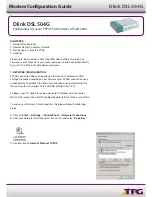
29
6193-3201
Contention Window Size
This configurable parameter was introduced in
firmware V1.18
This field sets the number of transmission slots
available for usage by Clients. Each Client in the
system has an individual time slot, to reduce
radio communications clash. This field can be set
to optimise throughput for particular applications.
When set to zero, this field is automatically
adjusted by the Access Point. When there is only
one Client connected to an Access Point, this is
automatically set to 1. Contention Window Size
will increase with each additional Client in the
system. Contention Window size will increase to
a maximum size of 7 – for more than 7 Clients,
slots are reused.
If making adjustment to this field, leave Clients
set to automatic, and adjust the value at the
Access Point. If traffic within the system is usually
only directed at a single Client at a time (such
as a master device polling slave devices), there is
some advantage in overall system speed by set-
ting the Contention Window Size low to perhaps
1 or 2.
Apply Changes
Update settings.
Apply Changes and Save
Update settings and save to non-volatile memory.
3.10 Spanning Tree Algorithm / Redundancy
The “Spanning Tree Algorithm” function was introduced to handle network loops and
provide redundant paths in networks. The Spanning Tree Algorithm can be configured,
however the factory default
setting is “disabled”.
For example, consider this
network with a redundant
wireless link. If the Spanning
Tree Algorithm function is
enabled, one of the two wire-
less links will be disabled
– that is, all wireless data will
be transferred by one link
only. If the active link fails, the
other link will automatically
start transferring the wireless
data.
The Spanning Tree Algorithm implemented is IEEE 802.1d compatible. The algorithm
forms a loop-free network by blocking traffic between redundant links in the network.
6XXZhhEd^ci7g^Y\Z
8a^Zci7g^Y\Z
6XXZhhEd^ci7g^Y\Z
8a^Zci7g^Y\Z
















































